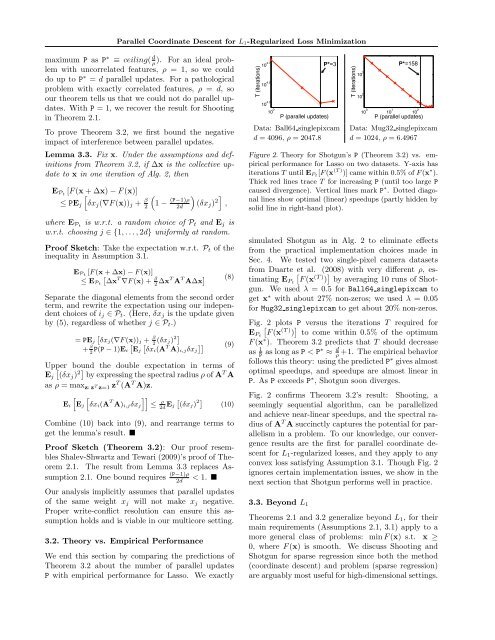Parallel Coordinate Descent for L1-Regularized Loss Minimization
Parallel Coordinate Descent for L1-Regularized Loss Minimization
Parallel Coordinate Descent for L1-Regularized Loss Minimization
You also want an ePaper? Increase the reach of your titles
YUMPU automatically turns print PDFs into web optimized ePapers that Google loves.
<strong>Parallel</strong> <strong>Coordinate</strong> <strong>Descent</strong> <strong>for</strong> L 1-<strong>Regularized</strong> <strong>Loss</strong> <strong>Minimization</strong><br />
maximum P as P ∗ ≡ ceiling( d ρ ). For an ideal problem<br />
with uncorrelated features, ρ = 1, so we could<br />
do up to P ∗ = d parallel updates. For a pathological<br />
problem with exactly correlated features, ρ = d, so<br />
our theorem tells us that we could not do parallel updates.<br />
With P = 1, we recover the result <strong>for</strong> Shooting<br />
in Theorem 2.1.<br />
To prove Theorem 3.2, we first bound the negative<br />
impact of interference between parallel updates.<br />
Lemma 3.3. Fix x. Under the assumptions and definitions<br />
from Theorem 3.2, if ∆x is the collective update<br />
to x in one iteration of Alg. 2, then<br />
E Pt [F (x + ∆x) − F (x)]<br />
≤ PE j<br />
[δx j (∇F (x)) j + β 2<br />
(<br />
1 − (P−1)ρ<br />
2d<br />
) ]<br />
(δx j ) 2 ,<br />
where E Pt is w.r.t. a random choice of P t and E j is<br />
w.r.t. choosing j ∈ {1, . . . , 2d} uni<strong>for</strong>mly at random.<br />
Proof Sketch: Take the expectation w.r.t. P t of the<br />
inequality in Assumption 3.1.<br />
E Pt [F (x + ∆x) − F (x)]<br />
≤ E Pt<br />
[<br />
∆x T ∇F (x) + β 2 ∆xT A T A∆x ] (8)<br />
Separate the diagonal elements from the second order<br />
term, and rewrite the expectation using our independent<br />
choices of i j ∈ P t . (Here, δx j is the update given<br />
by (5), regardless of whether j ∈ P t .)<br />
= PE j<br />
[<br />
δxj(∇F (x)) j + β 2 (δxj)2]<br />
+ β 2 P(P − 1)Ei [<br />
Ej<br />
[<br />
δxi(A T A) i,jδx j<br />
]] (9)<br />
Upper bound the double expectation in terms of<br />
E j<br />
[<br />
(δxj ) 2] by expressing the spectral radius ρ of A T A<br />
as ρ = max z: z T z=1 z T (A T A)z.<br />
E i<br />
[<br />
E j<br />
[<br />
δx i(A T A) i,jδx j<br />
]]<br />
≤ ρ<br />
2d Ej [<br />
(δxj) 2] (10)<br />
Combine (10) back into (9), and rearrange terms to<br />
get the lemma’s result. <br />
Proof Sketch (Theorem 3.2): Our proof resembles<br />
Shalev-Shwartz and Tewari (2009)’s proof of Theorem<br />
2.1. The result from Lemma 3.3 replaces Assumption<br />
2.1. One bound requires (P−1)ρ<br />
2d<br />
< 1. <br />
Our analysis implicitly assumes that parallel updates<br />
of the same weight x j will not make x j negative.<br />
Proper write-conflict resolution can ensure this assumption<br />
holds and is viable in our multicore setting.<br />
3.2. Theory vs. Empirical Per<strong>for</strong>mance<br />
We end this section by comparing the predictions of<br />
Theorem 3.2 about the number of parallel updates<br />
P with empirical per<strong>for</strong>mance <strong>for</strong> Lasso. We exactly<br />
10 4.5<br />
T (iterations)104.7 P (parallel updates)<br />
10 4.3<br />
10 0<br />
P*=3<br />
T (iterations)<br />
P*=158<br />
10 2<br />
10 0 10 1<br />
(parallel<br />
10 2<br />
updates)<br />
10 3<br />
Data: Ball64 singlepixcam Data: Mug32 singlepixcam<br />
d = 4096, ρ = 2047.8 d = 1024, ρ = 6.4967<br />
Figure 2. Theory <strong>for</strong> Shotgun’s P (Theorem 3.2) vs. empirical<br />
per<strong>for</strong>mance <strong>for</strong> Lasso on two datasets. Y-axis has<br />
iterations T until E Pt [F (x (T ) )] came within 0.5% of F (x ∗ ).<br />
Thick red lines trace T <strong>for</strong> increasing P (until too large P<br />
caused divergence). Vertical lines mark P ∗ . Dotted diagonal<br />
lines show optimal (linear) speedups (partly hidden by<br />
solid line in right-hand plot).<br />
simulated Shotgun as in Alg. 2 to eliminate effects<br />
from the practical implementation choices made in<br />
Sec. 4. We tested two single-pixel camera datasets<br />
from Duarte [ et al. (2008) with very different ρ, estimating<br />
E Pt F (x<br />
(T ) ) ] by averaging 10 runs of Shotgun.<br />
We used λ = 0.5 <strong>for</strong> Ball64 singlepixcam to<br />
get x ∗ with about 27% non-zeros; we used λ = 0.05<br />
<strong>for</strong> Mug32 singlepixcam to get about 20% non-zeros.<br />
Fig. [ 2 plots P versus the iterations T required <strong>for</strong><br />
E Pt F (x<br />
(T ) ) ] to come within 0.5% of the optimum<br />
F (x ∗ ). Theorem 3.2 predicts that T should decrease<br />
as 1 P as long as P < P∗ ≈ d ρ<br />
+1. The empirical behavior<br />
follows this theory: using the predicted P ∗ gives almost<br />
optimal speedups, and speedups are almost linear in<br />
P. As P exceeds P ∗ , Shotgun soon diverges.<br />
Fig. 2 confirms Theorem 3.2’s result: Shooting, a<br />
seemingly sequential algorithm, can be parallelized<br />
and achieve near-linear speedups, and the spectral radius<br />
of A T A succinctly captures the potential <strong>for</strong> parallelism<br />
in a problem. To our knowledge, our convergence<br />
results are the first <strong>for</strong> parallel coordinate descent<br />
<strong>for</strong> L 1 -regularized losses, and they apply to any<br />
convex loss satisfying Assumption 3.1. Though Fig. 2<br />
ignores certain implementation issues, we show in the<br />
next section that Shotgun per<strong>for</strong>ms well in practice.<br />
3.3. Beyond L 1<br />
Theorems 2.1 and 3.2 generalize beyond L 1 , <strong>for</strong> their<br />
main requirements (Assumptions 2.1, 3.1) apply to a<br />
more general class of problems: min F (x) s.t. x ≥<br />
0, where F (x) is smooth. We discuss Shooting and<br />
Shotgun <strong>for</strong> sparse regression since both the method<br />
(coordinate descent) and problem (sparse regression)<br />
are arguably most useful <strong>for</strong> high-dimensional settings.



